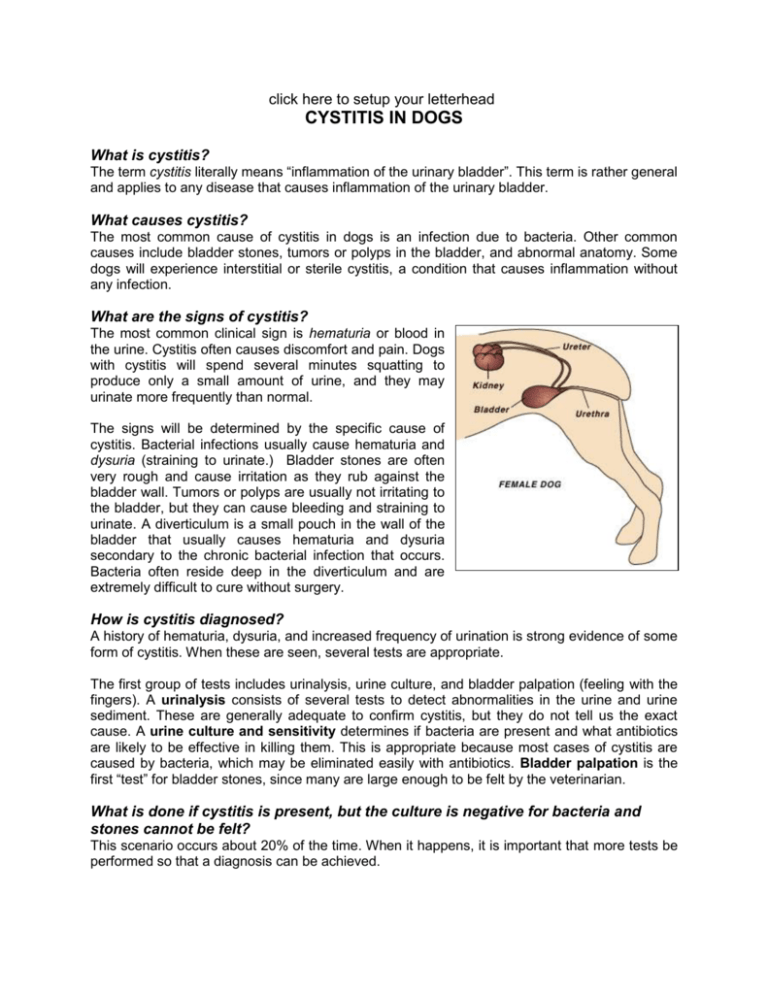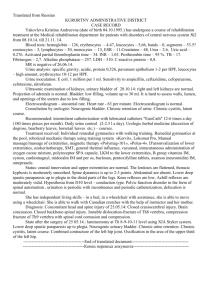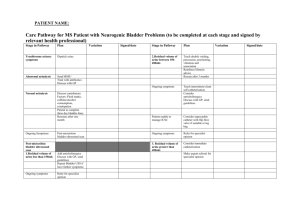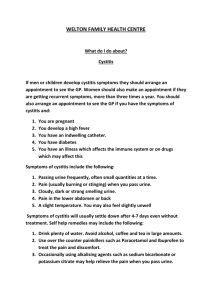CYSTITIS IN DOGS - Alpine Animal Hospital
advertisement

click here to setup your letterhead CYSTITIS IN DOGS What is cystitis? The term cystitis literally means “inflammation of the urinary bladder”. This term is rather general and applies to any disease that causes inflammation of the urinary bladder. What causes cystitis? The most common cause of cystitis in dogs is an infection due to bacteria. Other common causes include bladder stones, tumors or polyps in the bladder, and abnormal anatomy. Some dogs will experience interstitial or sterile cystitis, a condition that causes inflammation without any infection. What are the signs of cystitis? The most common clinical sign is hematuria or blood in the urine. Cystitis often causes discomfort and pain. Dogs with cystitis will spend several minutes squatting to produce only a small amount of urine, and they may urinate more frequently than normal. The signs will be determined by the specific cause of cystitis. Bacterial infections usually cause hematuria and dysuria (straining to urinate.) Bladder stones are often very rough and cause irritation as they rub against the bladder wall. Tumors or polyps are usually not irritating to the bladder, but they can cause bleeding and straining to urinate. A diverticulum is a small pouch in the wall of the bladder that usually causes hematuria and dysuria secondary to the chronic bacterial infection that occurs. Bacteria often reside deep in the diverticulum and are extremely difficult to cure without surgery. How is cystitis diagnosed? A history of hematuria, dysuria, and increased frequency of urination is strong evidence of some form of cystitis. When these are seen, several tests are appropriate. The first group of tests includes urinalysis, urine culture, and bladder palpation (feeling with the fingers). A urinalysis consists of several tests to detect abnormalities in the urine and urine sediment. These are generally adequate to confirm cystitis, but they do not tell us the exact cause. A urine culture and sensitivity determines if bacteria are present and what antibiotics are likely to be effective in killing them. This is appropriate because most cases of cystitis are caused by bacteria, which may be eliminated easily with antibiotics. Bladder palpation is the first “test” for bladder stones, since many are large enough to be felt by the veterinarian. What is done if cystitis is present, but the culture is negative for bacteria and stones cannot be felt? This scenario occurs about 20% of the time. When it happens, it is important that more tests be performed so that a diagnosis can be achieved. Bladder radiographs (x-rays) are taken to evaluate the bladder for common types of bladder stones. However, the mineral composition of some stones requires that special radiographs, using contrast materials, be utilized. Plain radiographs are usually not able to reveal bladder tumors, polyps, or diverticula. A plain radiograph can be made without sedation or anesthesia in most dogs. An ultrasound examination is also useful in evaluating the bladder. This technique uses sound waves to visualize stones and some tumors and polyps. It may also identify other abnormalities of the bladder wall, including wall thickening. It can often be performed without sedation or anesthesia. Contrast radiographs are taken when plain radiographs and an ultrasound examination do not provide the diagnosis. In this three-step process, the bladder is first filled with a negative contrast material (usually air), then a positive contrast material (a special radiographic dye), and finally a positive contrast material with a negative contrast material (double contrast study). A radiograph is taken after each step. These three procedures permit visualization of otherwise unseen bladder stones, tumors and polyps, diverticula, and wall thickening. Since it is necessary to pass a catheter into the bladder and to distend it with the contrast materials; general anesthesia is required. Dogs showing other signs of illness, such as fever, poor appetite, or lethargy, should also be evaluated for systemic diseases and bleeding disorders that may be causing hematuria. For these dogs, a biochemistry profile and complete blood count (CBC) should be performed. If a clotting problem is suspected, a bleeding profile is appropriate. How is cystitis treated? Treatment depends on the cause. Bacterial infections are generally treated with antibiotics. Some bladder stones can be dissolved with special diets while others require surgical removal. Benign bladder polyps can usually be surgically removed, but malignant bladder tumors are difficult to treat successfully. A bladder diverticulum should be removed surgically. Your veterinarian will discuss the appropriate tests and treatments necessary to return your pet to normal health as soon as possible. This client information sheet is based on material written by Ernest Ward, DVM. © Copyright 2005 Lifelearn Inc. Used with permission under license. February 15, 2016









